Carrots may be one of the most familiar vegetables in the produce section, but the bland and lifeless tubers you find in most supermarkets bear little resemblance to the juicy, crunchy and intensely sweet varieties you can grow yourself or find at your local farmers’ market. These varieties — which include Scarlet Nantes, Purple Dragon, Yellowstone, White Satin and Red Samurai — deliver hints of pine, wood, oil, citrus and mint. They also offer a range of colors and nutrients, not just the beta-carotene for which they are famed. Researchers have found that carrots can help you ward off cancer, cardiovascular disease and glaucoma — one more reason to rediscover them and add them to your next meal.
Quick and Easy
- Peel/Grate: Toss grated or long peels of carrots with Greek yogurt, a little fresh grated ginger, and cayenne for a simple, tasty salad. Add a handful to cooked brown rice, salads or even soups for quicker cooking.
- Purée: To make a dip for veggies, or a spread for sandwiches or crostini, purée roasted carrots (shred or chop fine for faster cooking) with tahini, ginger and tamari.
- Glaze: Sauté carrots in olive oil; add enough chicken or vegetable stock to cover. Season with garlic and thyme, then simmer uncovered on the stovetop until glazed and tender.
- Steam: When you want simple cooked carrots, steam instead of boil and drizzle with extra-virgin olive oil or butter.
- Juice: For a vibrant-tasting juice, run two large carrots through a juicer with two stalks of celery, one tart apple and a 1-inch chunk of fresh ginger.
- Roast: Place carrots in a baking dish greased with coconut oil, ghee or extra-virgin olive oil. Add whole cumin seeds, salt and cayenne pepper and roast at 400 degrees F until browned and tender.
Nutrition Know-How
- A new study has shown that, as a group, yellow and orange fruits and vegetables — particularly carrots — are more effective than produce of other colors at reducing the risk of cardiovascular disease.
- Certain phytonutrients in carrots have been found to inhibit the growth of colon cancer cells. Beta-carotene, which gets its name from the carrot, is a pro-vitamin-A compound. Vitamin A helps your body fight viruses.
- Beta-carotene, which also supports the reproductive system and protects cells from free radicals, becomes more bioavailable when carrots are lightly steamed.
Kitchen Tricks
- If your carrots are slender and organic, there’s no need to peel them. More mature carrots — and those exposed to hot temperatures, sunlight or damage — can taste bitter; thinly peel off the outer layer to reveal the sweeter flesh.
- The “baby carrots” sold at grocery stores are often mature carrots that have been peeled, whittled, packaged and shipped long distances. For fresher, tastier carrots, peel and cut your own carrot sticks and store in a little water in the refrigerator.
- When cooking, select the color of carrots based on use. Orange, yellow and white carrots tend to hold their color when cooked with other foods. More deeply colored carrots — which get their red and purple hues from anthocyanins — tend to turn soups and stews brown.
Shopping and Storage Tips
- Look for firm, smooth carrots without cracks.
- You can tell carrots are freshly picked when their bright greenery is attached. But over time the greenery robs carrots of moisture and vitamins, so remove them as soon as you bring them home.
- Store unwashed carrots in a sealed bag or container in the refrigerator to prevent moisture loss. They will usually keep for a few weeks. Slightly older carrots are still fine for soups.
Recipes!
Shredded Carrot and Currant Salad
The Middle Eastern–inspired flavors of orange flower water and cinnamon pair well with raw carrots in this quick-and-easy salad.
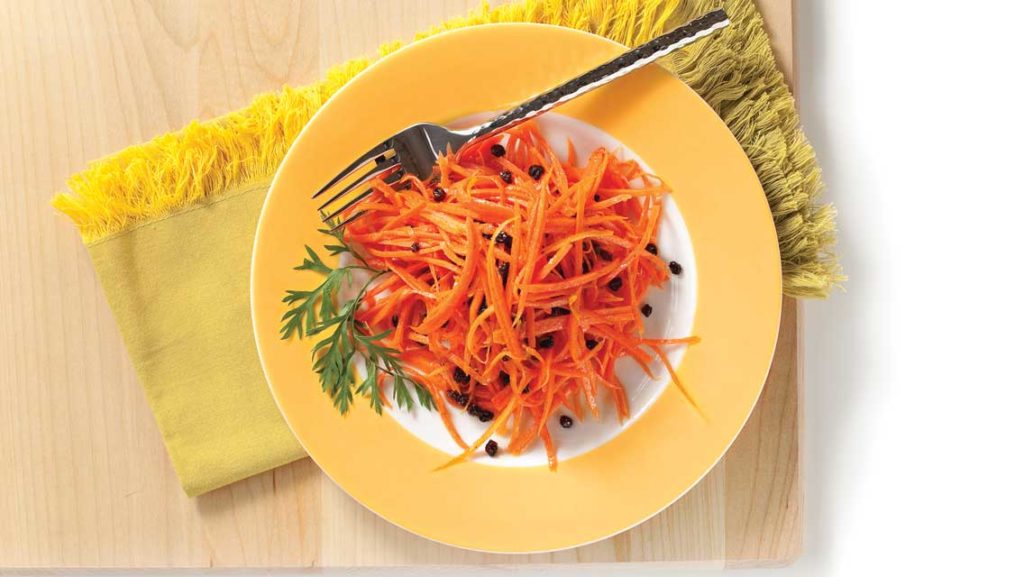
Serves | four
- 4 cups carrots, peeled, shredded with a grater and packed
- 1/4 cup dried currants
- 1/2 tsp. orange flower water (available at a Middle Eastern or gourmet market, as well as online)
- 2 oranges, juiced and zested
- 1/2 tsp. ground cinnamon
- Salt and freshly ground black pepper to taste
- 1/4 cup extra-virgin olive oil
Directions
- Toss the grated carrots with the currants in a medium salad bowl.
- In a small bowl, whisk together the orange flower water (omit if it’s not readily available), orange juice and zest, cinnamon, salt, pepper, and extra-virgin olive oil. Toss dressing with the currants and carrots.
- Store salad in the refrigerator until ready to serve. Keeps well for two to three days.
Curried Carrot Soup
This vibrant and velvety soup is great hot or chilled. Try it with a dollop of Greek yogurt or sour cream on top.
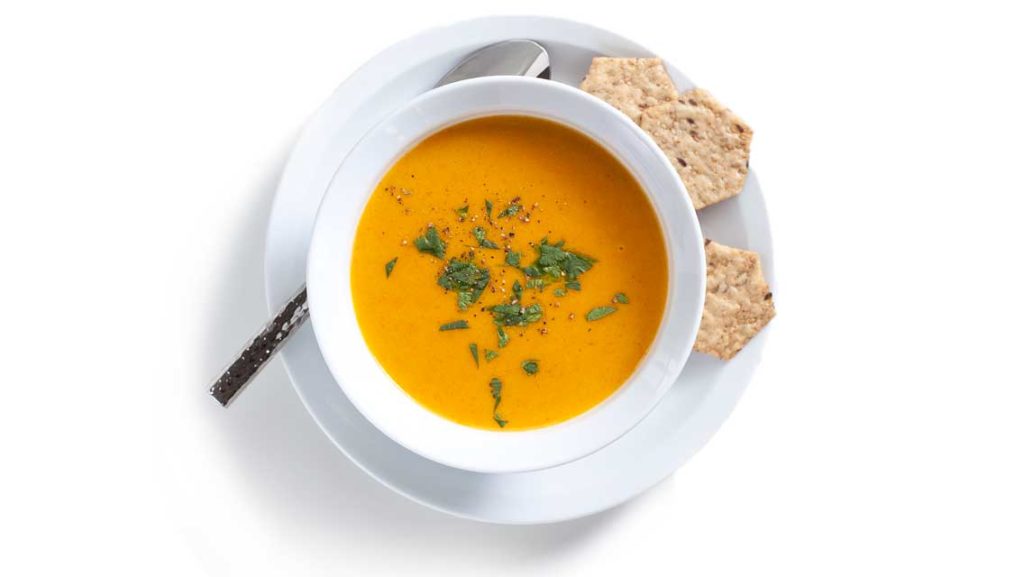
Serves | four
- 1 tbs. ghee or coconut oil
- 1 yellow onion, chopped (about 1 cup)
- 2 stalks celery, chopped (about ¾ cup)
- 3 1/2 cups carrots, peeled and chopped
- 2 tbs. minced ginger
- 1 tbs. curry powder
- 1 can coconut milk (about 14 ounces)
- 4 cups vegetable stock
- 1/2 tsp. salt, or to taste
- Dash of cayenne pepper
- Chopped fresh cilantro
- Freshly ground black pepper
Directions
- Heat the ghee in a heavy saucepan and sauté the onion, celery and carrots until just tender.
- Add the ginger and curry powder and sauté for another five minutes until aromatic.
- Add coconut milk and vegetable stock, and simmer until vegetables are tender. Blend the soup with an immersion blender or in small batches in a regular blender until smooth.
- Season with salt and cayenne pepper to taste. Garnish with chopped fresh cilantro and freshly cracked black pepper.
Carrot Fritters
Serve these little “latkes” on a bed of greens for a delightful appetizer or lunch.
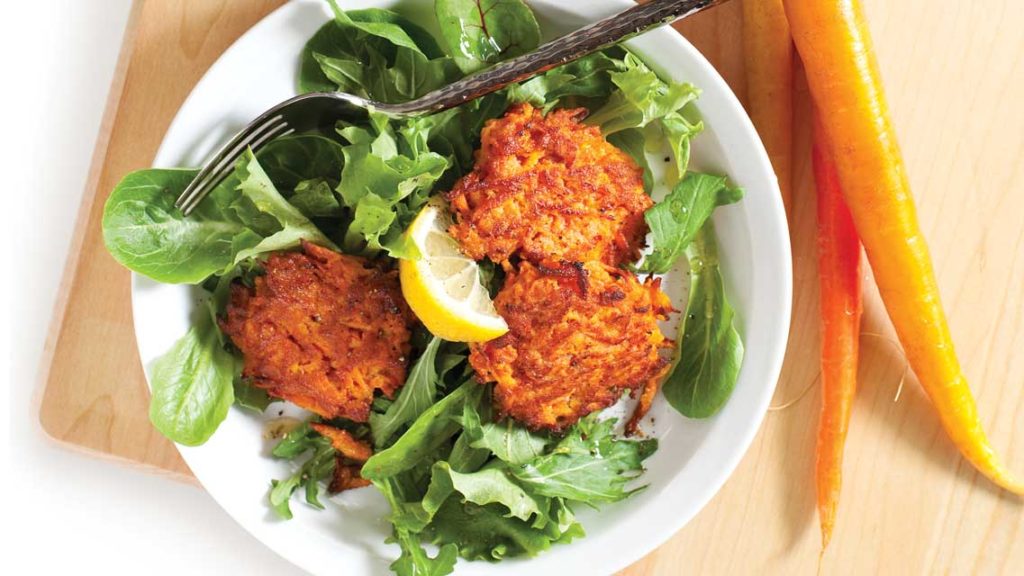
Makes about | 16 small fritters; serves four
- 4 cups grated carrots, packed
- 1/4 cup rice flour, coconut flour or whole-wheat flour
- 1/2 tsp. baking powder
- 4 eggs, beaten
- 1 tbs. grated fresh ginger
- 1/2 tsp. salt
- Freshly ground black pepper to taste
- 1/2 cup olive oil for frying
Directions
- Toss the carrots with the flour and baking powder. Mix in beaten eggs, ginger, salt and pepper.
- Heat the oil to 350 degrees F.
- Shape about a tablespoon of the carrot mixture into flat patties and carefully lower into the hot oil. After one to two minutes, gently turn each latke over to brown the other side (about another minute).
- Keep the latkes on a baking sheet in a warm oven while you fry the remaining carrot mixture.
- Garnish with chopped fresh chives and Greek yogurt or sour cream, if you’d like.
Deborah Madison’s Carrot and Carrot-Top Soup
Don’t just throw them away! The tender tops that come with your carrots are delicious in soups. Here’s one that uses both the carrots and their tops.
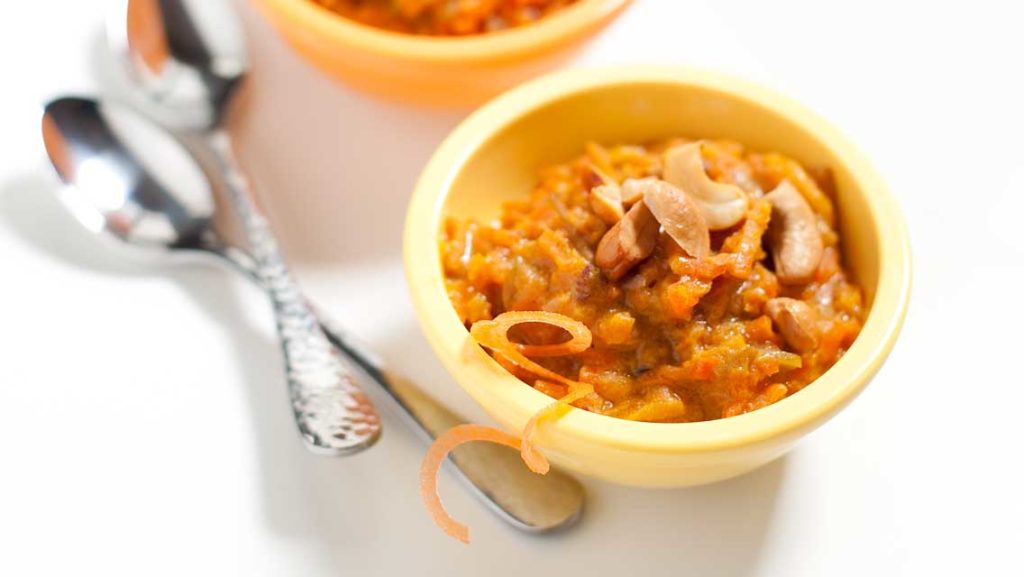
Serves | four
- 1 bunch carrots, the tops and the roots (6 smallish to medium sized)
- 2 tbs. butter
- 3 tbs. rice
- 2 large leeks, the white part, or 1 onion, finely diced
- 2 sprigs of thyme or lemon thyme
- 2 tbs. chopped dill, parsley, celery leaves or lovage
- 6 cups light chicken stock, water or vegetable stock
- Sea salt and freshly ground pepper
Directions
- Pull or pluck the lacey leaves of the carrot greens from their stems. You should have between 2 and 3 cups, loosely packed. Wash, then chop finely. Grate the carrots, or, if you want a more refined looking soup, finely chop them.
- Melt the butter in a soup pot. Add the carrot tops and carrots, rice, leeks, thyme and herb. Cook several minutes, turning everything a few times, then season with 1 1/2 teaspoons salt and add the stock. Bring to a boil and simmer until the rice is cooked, 16 to 18 minutes.
- Taste for salt, season with pepper, and serve.
Carrot Halva
This traditional Indian treat often contains a lot of white sugar. Not this version. The natural sweetness of the carrots and dates in this recipe makes for a tasty and satisfying dessert.
Serves | six
- 1 tbs. ghee
- 1/4 cup raw cashews, chopped coarsely
- 2 cups grated carrot
- 2 tbs. chopped dates (about 4 dates)
- 1 pinch saffron, optional
- 1 cinnamon stick, about 2 inches long
- 5 whole cardamom pods, crushed slightly or ½ tsp. ground cardamom
- 2 cups whole milk
Directions
- Heat ghee in a heavy skillet and sauté cashew pieces, stirring constantly until golden brown on both sides. Remove cashews from skillet and set aside.
- Add the grated carrot to the skillet and cook while stirring until tender, about five minutes. Add the dates, saffron, cinnamon and cardamom.
- Stir in the milk and cook over medium heat, stirring occasionally to make sure the mixture does not bubble over. As the milk reduces, lower the heat and continue to stir so you do not scorch the mixture.
- Continue to cook over low heat and stir until almost all of the milk has been reduced. Remove from heat and cool mixture in serving dish. Serve with the toasted cashews and additional chopped dates if you want more sweetness.
- Serve warm or cold. Keeps well in the refrigerator for two to three days.
Non-Dairy Carrot Halva
Serves four
- 1/4 cup toasted cashews
- 2 cups grated carrot, packed
- 1 tsp. coconut oil
- 1/2 cinnamon stick, crushed
- 4 cardamom pods, crushed
- 8 pitted dates, chopped
- 1 pinch saffron (optional)
- 1 cup coconut milk (don’t use the light coconut milk)
Directions
- Heat coconut oil in a heavy skillet and sauté the carrot in the skillet until cooked through. Add the cinnamon stick, cardamom pods, dates and saffron, and then stir in the coconut milk. Simmer the mixture until coconut milk is reduced and the carrot mixture has thickened. This should take about 10 minutes.
- Store refrigerated until ready to eat. Top with toasted cashews.
All of these recipes were created by Betsy Nelson (a.k.a. “That Food Girl”), a Minneapolis-based food stylist and recipe developer
Fresh From the Earth
Chef Deborah Madison adores carrots fresh from the ground. Although she is more of “a farmers’ market shopper” than a gardener, Madison recently planted a variety of carrots, including Danvers (“a great big, pointy heirloom carrot”) and an assortment of scarlet, white, yellow and orange varieties. That mix gives her a rich harvest for cooking. The author of 11 cookbooks, Madison favors locally grown and heirloom fruits and vegetables in her work. She is currently writing Vegetable Literacy, a cookbook focusing on plant families and how the relationships between various plants might make us think about cooking them in a different way. She talked with us about what makes good carrots — and what to do with those lovely tubers in the kitchen.
EL: Can you describe the flavor of freshly picked carrots?
DM: It’s a really lovely combination of earthy and sweet. Beets are similar, but they’re
intensely earthy and extremely sweet. Carrots are a bit more balanced. The earthiness is there, but it’s not a detraction. The sugars give carrots a nice uniform taste, complexity, and a wonderful aliveness.
EL: What are some easy ways to prepare carrots?
DM: I use them in the morning to make juice, and I use them in carrot salads. Another wonderful method is to cover them with a little water or stock, and a little butter, and you let the water cook away and they glaze at the end. People seem to love those. Similarly, they love roasted carrots, and I do, too. I braise them in the oven first, and then remove the cover at the end, so that they can roast and get nice and brown. Their sweetness comes out from the caramelization. The other thing I love is carrots in a soup, whether you want to go for Asian flavors like coconut, chili and cilantro or stick with traditional seasonings such as thyme and other earthy herbs that settle carrots’ sweetness a little bit.
EL: What other flavors complement carrots?
DM: Carrots are umbellifers [plants named for the umbrella-like flower clusters they produce] and all the herbs in that family — cumin, caraway, anise, parsley, cilantro and dill — taste good with carrots.
EL: What’s the difference between a carrot that comes from the backyard or a farmers’ market and a typical supermarket carrot?
DM: At a farmers’ market, you have a much better chance of getting a carrot that tastes exceptionally good. If it’s a real farmers’ market, it’s going to have local and seasonal produce, and that always has the best chance for great flavor. You’re dealing with people who, generally, are serious farmers trying to grow top-notch vegetables, who have small farms, who are able to work in a different economy of scale than some huge conglomerate of farms. So they tend to choose better varieties and to grow them better. They take far better care of their soil, which makes a difference, too. And they have fabulous stories.
EL: Rumor has it, you’re not a big fan of so-called baby carrots. Why?
DM: Given the option, I don’t know why anybody would do themselves the disfavor of eating those little, flavorless, dried-out things in a plastic bag. When carrots are really good, like the ones you find at the farmers’ market, kids love them. Everybody loves them. They’re just that delicious. And the nutritional benefits are just a bonus.
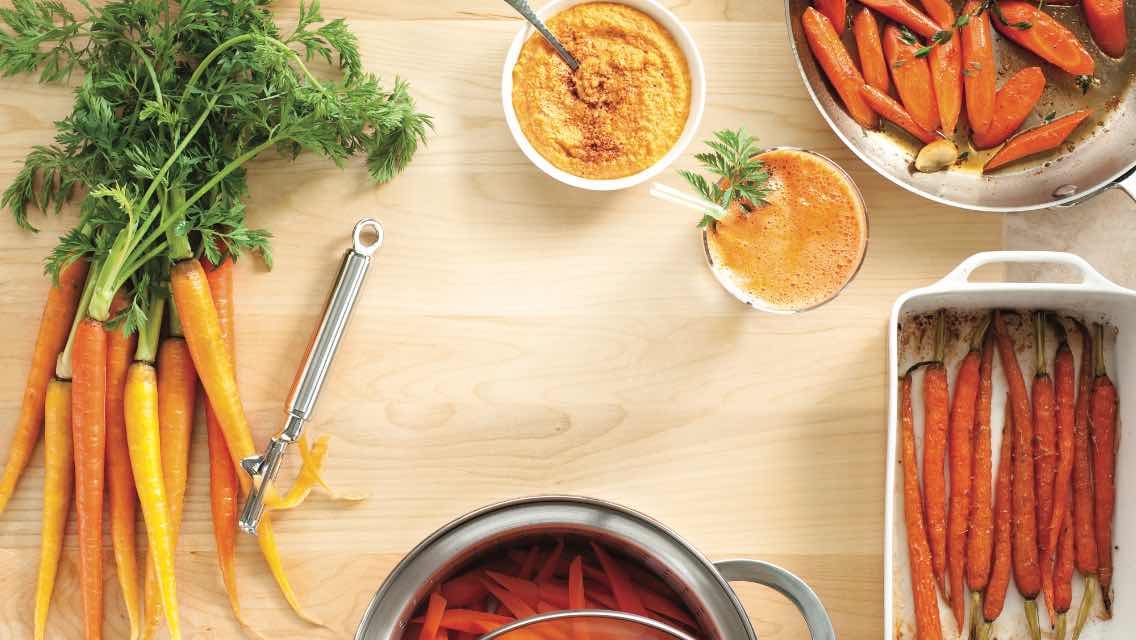

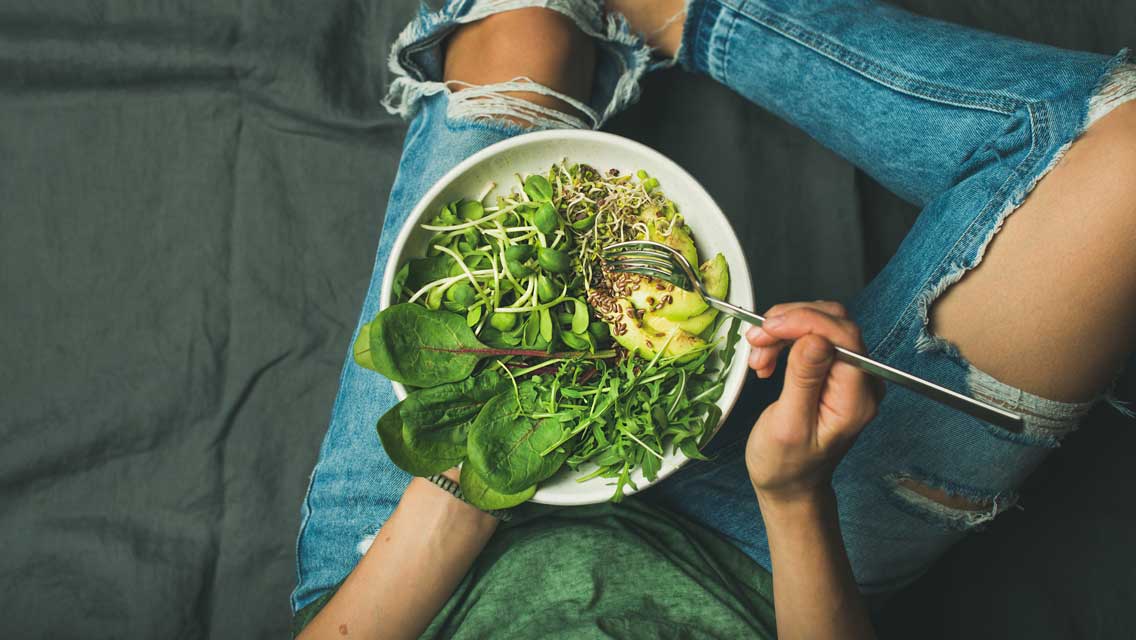
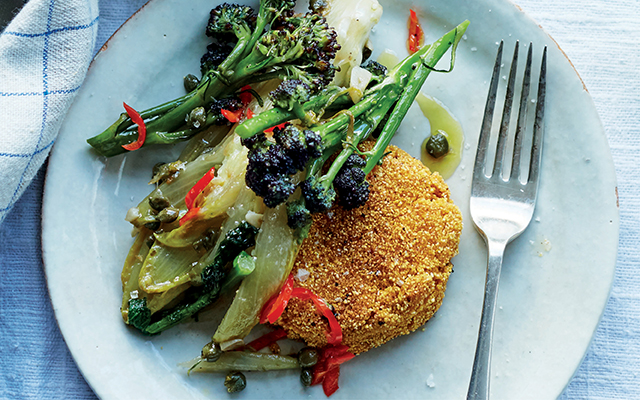
This Post Has 0 Comments